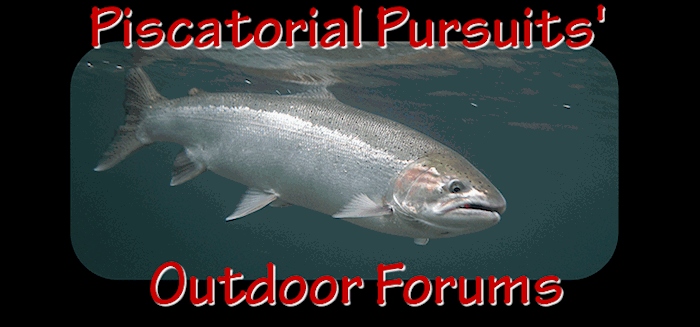Bob,
I appreciate that you're busy with the FHMP on the Cowlitz...I'm sure you noticed that in my earlier perspective that most everyone who is complaining about this regulation has not, and generally does not, get involved any more than standing on the sidelines b!tching did not include you. I know how much time you put into Cowlitz River issues on behalf of sportsmen.
I guess there are three ways to address your question regarding the WSP...
1. Ask you to point out exactly where the Commission is breaking the law (I already tried that one...don't post two pages of words; show me where they're breaking the law...make a point, don't ask me to find the connection in your head)
2. When you ask if I think it was illegal, I'll tell you the answer (no). (I already tried that, but you keep doing #1 over and over, that is, asking me to read your mind rather than just tell me what your point is).
3. Go through whatever you post and try to make heads or tails over what you're getting at...I tried that with the RCW's, which you then said wasn't what you meant, then I tried it with parts of the WSP, which you then said wasn't what you meant, and now I suppose I'll try it again with what you posted.
If the answer once again is not the one you're looking for, please DO NOT just post a bunch of stuff and ask if I can now read your mind.
ASK ME a specific question...something like this:
"Section (whatever), paragraph (wherever) of the WSP says this: (then say it). The WDFW Commission passed this regulation, which seems to violate the above section in this way (SAY THE WAY)." Please do not ask me to read your mind or figure out what the heck your point is anymore...just spit it out.
You posted:
"Obviously, you would not encourage people to read it anyway other then the way that you would like them to. People can read, and people can draw their own conclusions."
Not true...I just want to know
what exactly your conclusion
is, which doesn't mean "I conclude they broke the law." It does include "This is the specific piece of law that they broke, here is where their action is contrary to what this piece of law tells them they have to do."
Here goes...
Performance Standards
1. Harvest management will be responsive to annual fluctuations in abundance of salmonids, and will be designed to meet any requirements for sharing of harvest opportunity.
2. The allowable incidental harvest impact on populations shall be addressed in existing preseason and in-season planning processes as described in policy number 1.
3. Where a population is not meeting its desired spawner abundance level, the State, in managing the non-treaty harvest, may give priority to non-treaty fisheries that can minimize their impacts on weak stocks and increase their harvest on healthy stocks by: (1) using gears that can selectively capture and release stocks with minimal mortality, or (2) avoid impacts by eliminating encounters with weak populations (proven time/area closures, gear types). This must be done consistent with meeting treaty and non-treaty allocations and in accordance with agreed mass marking policies.
This says (1) harvest levels will change as conditions change, (2) incidental impacts will be determined pre-season, and with in-season adjustments per Policy 1, and (3) if desired abundance is not being met, priority will be given to fisheries that are more selective either by using more selective gear or fishing in times/places where there will be less encounters of depressed fish. The final sentence means that non-treaty fishers aren't allowed to catch more than their share just because they use more selective gear types, such as the situation with the Col. R. gillnet fishery.
This third sentence also applies in a sportfishing situation like on the Col. R. Since the sporties get a shot at a lot of hatchery springers in the Wilamette, or the Wind, where the tribes aren't allowed to net, the tribes will get their share out of the Columbia.
I can't see anything in this entire section that has anything to do with WSR regulations.
Spawning Escapement Policy
2. Policy Statement
The wild populations or management units to which this spawner escapement policy applies will be defined on a comprehensive, statewide, or regional basis, recognizing scientific uncertainty, in accordance with policy statement #1. The parties will review existing court orders, joint agreements, and management plans to determine if it is agreed whether modifications are necessary to be consistent with the goals of this Policy. Within this context, sufficient escapement of appropriate naturally spawning fish will be provided to encourage local adaptation and maximize long-term surplus production that sustains harvest, and to provide for recreational opportunities and ecological benefits.4 Exceptions to this general policy may be developed on a regional basis through agreement of the Department and affected Tribes to provide for recovery and rebuilding of wild stocks or where natural productivity is low.
Ok, we're missing lots of stuff that comes right before the quoted sections, but we'll work with it...
Management units will be defined in one of many ways, which can be modified if they both agree, escapements will be set at appropriate levels, for long term production that sustains harvest (*this means "commercial harvest"*), recreational opportunities (*this means "recreational harvest"*), and ecological benefits (other ecosystems/animals that depend on salmon being in the river, like eagles and bears). Exceptions to this can be made if there are certain needs of low productivity runs (they can agree to higher escapements or lower harvests if the runs need it).
Again, no application to WSR regulations...it just says how escapements are set, and why they're set.
Performance Standards
1. In each watershed region, for each species, populations and/or management units to which MSH management will apply shall be identified and the pertinent management agencies shall establish escapement goals designed to achieve MSH. MSH shall be calculated by using long-time series of accurate spawner and recruit statistics for each population. When such statistics are not available, MSH may be calculated by using historical production, habitat availability, or the best available methods for calculation.
2. The State and Tribes will seek agreement on the total escapement rates, escapement levels, or escapement ranges that are most likely to maximize long-term surplus production for wild populations or combinations of wild populations or management units. These rates, levels, or ranges will be based upon achieving MSH and will account for all relevant factors, including current abundance and survival rates, habitat capacity and quality, environmental variation, management imprecision, and uncertainty, and ecosystem interactions.
3. For other resident and anadromous trout and char, managers may employ wild fish release and other approaches that can maintain high abundance as agreed upon in watershed or sub-regional management plans that may be developed between the Department and the affected Tribes after consultation with affected stakeholders and pursuant to applicable law and court orders. Where an affected Tribe has not chosen to participate in such management, the Department may continue to rely on the escapement approach for wild managed populations contained in A Basic Fishery Management Strategy for Resident and Anadromous Trout in the Stream Habitats of The State of Washington adopted in 1986.
4. It will not be necessary to physically measure spawner abundance for each and every stock, though every stock will need to be covered by the inventory process. Index stocks that are typical of stocks within an area may be used to estimate abundance for the entire area. Surrogate measures such as standing stocks, random samples, stock composition or other measures may be substituted for actual measures of spawners. Evidence of the utility of such surrogates will need to be established for their use.5
5. If spawner management goals are not achieved for three consecutive years, or if the five-year moving average of spawner abundance falls below 80% of the goal, a management assessment including all factors responsible for the failure to reach this goal (e.g., forecast harvest rate estimates, environmental variation or spawner enumerations, appropriateness of spawner abundance goals, loss of habitat quantity and quality) will be completed within six months to determine the cause(s). The Department and affected Tribal parties will cooperatively design and implement appropriate actions to return spawning levels to, or above, the goal. Actions will include any necessary measures to meet the goals of this Policy.
Last section...
1. Escapements should be set for each management unit, and a couple of ways to set them.
2. State and tribes will seek to agree on the escapements, and the factors they should look at when setting them.
3. The state may use Wild Fish Release, or other approaches, to help maintain fish abundance or management plans that the co-managers have agreed upon. If the state and tribes have not entered into any agreed upon management plans, the state can use its older 1986 plan.
4. You don't have to count each and every run, instead you can use "index" runs, ones that tend to reflect the health of surrounding runs.
5. If escapement is not met 3 years in a row, or the 5 year average falls below 80%, they have 6 months to write a management plan that addresses all the reasons why. The state and the tribes will utilize the plan to fix the problem.
Again, this has nothing to do with WSR regulations.
Now I know I'm just a biased attorney, but the sections you culled out of the WSP don't have anything to do with this entire conversation. I encourage you to find an attorney of your own to answer these questions to your satisfaction, but my opinion is that you just went through the WSP looking for the word "harvest", copied it down, and re-printed it here without any regard for what it's actually saying.
Please get an attorney and run it by him or her. I don't want you to think I'm pulling the wool over your eyes, so please ask someone other than me.
My opinion, again, is that none of what you have printed here has anything to do with WSR.
As I noted at the beginning of this post, please DO NOT just print out a bunch more stuff and ask me to read your mind...ask specific questions about specific pieces of law, or make specific comments about specific pieces of law. Please dont cut and paste several more pages of the WSP and ask at the end if you're the only one who sees the connection...make the connection, point it out, so that I know what it is you're getting at.
I'm sorry to be so repetitive on that, but along with your great enthusiasm for doing research and re-printing various laws, you also tend to give them little or no analysis. You just print 'em out and say "THERE! See what I mean!", and the answer is usually, "no, point it out".
Fish on...
Todd.















 Previous Topic
Previous Topic Index
Index



